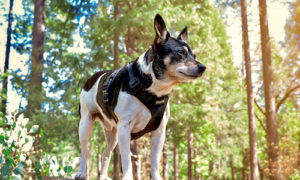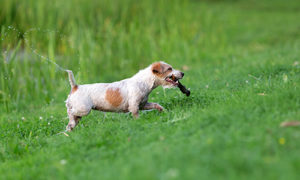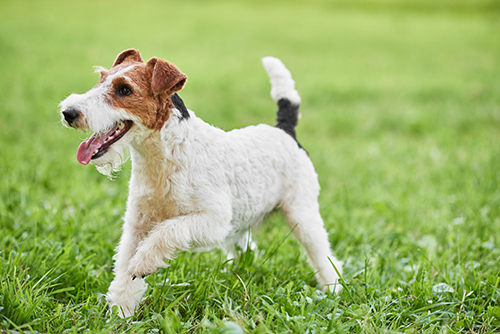
The Wirehaired Fox Terrier is the ultimate show dog, and it has its roots as a highly effective hunting dog. Its ancestors were skilled at dispatching, especially foxes, that had gone to ground. Some people say that the Smooth and Wire fox terriers came from distinct backgrounds, with the Wirehaired descending from the rough-coated Black and Tan Terrier of Wales.
The Wirehaired Fox Terrier entered the show ring about fifteen to twenty years after the smooth debuted. Both varieties were interbred extensively to improve the wirehaired type by reducing its size, boosting the white on its coat, and revealing a sleeker outline. The goal was met almost immediately.
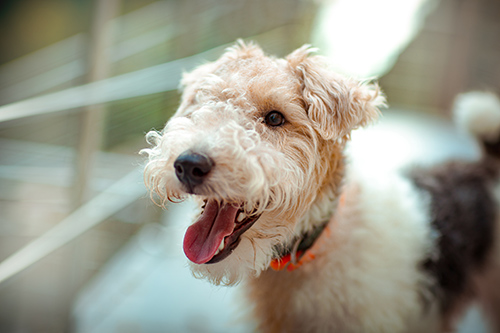
The AKC Divided the Dogs
Wirehaired Fox Terriers became highly popular after World War II. One hundred years after establishing the American Fox Terrier Club in 1985, the AKC divided the dog into two breeds. During that century, they were many successes for the breed both as a pet and show dog. The decision to separate into two varieties seemed logical because they were no longer interbred.
Breed Standard
The Wirehaired Fox Terrier is a small, compact, well-balanced dog, described in the standard as standing like a “cleverly made hunter.” The Fox Terrier has square proportions, a short, level back, a deep chest, a high-set tail carried up but not over the back, straight legs, and round, compact feet. The dog’s skull is flat and narrow, and its muzzle gradually tapers. The eyes are small, round, deep-set, dark, and ultimately fire. The ears are small and V-shaped, erect at the base with tips that fall forward, close to the cheeks.
Breed Facts
| Energy level | Watchdog ability | ||
| Exercise requirements | Protection ability | ||
| Playfulness | Grooming requirements | ||
| Affection level | Cold tolerance | ||
| Friendliness toward dogs | Heat tolerance | ||
| Friendliness toward other pets | Friendliness toward strangers | ||
| Ease of training |
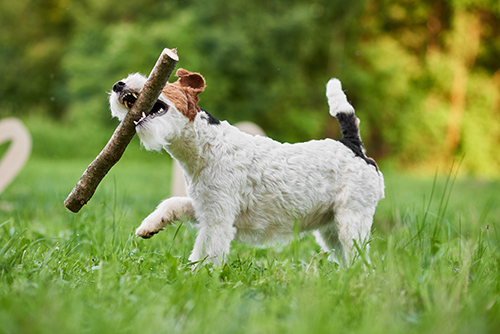
Activity Level: High. Fox Terriers need plenty of exercise on a leash or a fenced-in yard because they will not hesitate to chase small animals. The dogs also excel in dog sports such as obedience and agility, allowing them to exercise their minds and bodies. They can also exercise on their own if given the room. However, their much better off with a vigorous play session, long walk, or a hike.
- Popularity: Somewhat uncommon
- Family Group: Terrier
- Country of Origin: England
- Date Developed: 1800s
- Original Purpose: Vermin hunting, fox bolting
- Today’s Function: Earthdog trials
- Other Name: None
AKC recognition: 1885.
Group: Terrier
Grooming
The breed’s coat needs to be brushed weekly. Wires need regular stripping and clipping. Puppies need to be trained to cooperate with grooming routines. The younger, the better.
Coat: wiry, dense, broken-textured outer coat, comparable to the texture of coconut matting, with a fine, soft undercoat
Color: Primarily white with markings on the head and body.
Wirehaired Fox Terrier Temperament
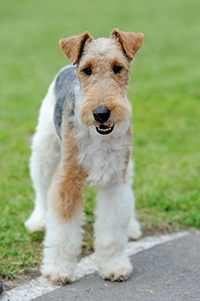
This Fox Terrier is a quick, keen, and cheerful dog that makes for a lively and energetic companion. Living with this breed is never dull. However, potential owners need to be prepared for a dynamic housemate. The dogs are curious and playful and can get into trouble if not adequately supervised with plenty of structured routines and exercises and mental challenges. The dogs possess a strong hunting instinct, but they can be taught to accept rabbits and cats if socialized to them as puppies.
Loves Adventure
The Wirehaired Fox Terrier is always ready for an adventure, which is why it is known as a true “live-wire.” They enjoy playing, running, hunting, exploring, and chasing. As mentioned earlier, the dogs can be naughty and independent and are likely to dig and bark. The breed is also somewhat reserved when it comes to strangers. The wire has built a reputation for being spunkier with other dogs than the smooth.
Health
- Main Health Concerns: none
- Minor Health Issues: lens luxation, distichiasis, cataract, Legg-Perthes
- Rarely Seen: deafness, patellar luxation
- Recommended Tests: (eye), cardiac, knee
- Life Span: 10 to 13 years
- Fox Terrier Weight: male – 17 to 19 pounds; female – 15 to 17 pounds
- Height: male – should not exceed 15.5 inches;
Breeder and Buyer’s Advice.

The Wirehaired Fox Terrier is a generally healthy and hardy dog, especially when purchased from a trusted and reputable breeder. The parent club’s website will have plenty of resources and information about accepted breeders with Wirehaired Fox Terrier puppies for sale. The Wire Fox Terrier price will depend on the particular breeder and the dog’s pedigree. You can also adopt Wire Fox Terrier looking for new homes. Not only is it cheaper than getting a Wirehaired Fox Terrier for sale, but the contribution you will make getting unwanted and endangered dogs off the street will be well worth it.
Parent Club: American Fox Terrier Club; founded in 1885
Regional Clubs: The American Fox Terrier Club maintains a list of regional affiliates on its website.
Rescue: Visit the parent club website for more information on rescue dogs.
Frequently Asked Questions
- Is a Wire Fox Terrier a good pet? Yes, but be prepared for a mischievous and independent companion at times.
- Do wire haired fox terrier bark a lot? Yes. The breed tends to dig and bark a lot.
- Do wirehaired terriers make good pets? Absolutely.
- Do wirehaired Fox Terriers shed? Yes, but not much. They’re not considered extreme shedders like some dogs, but they still need to brushed regularly.


